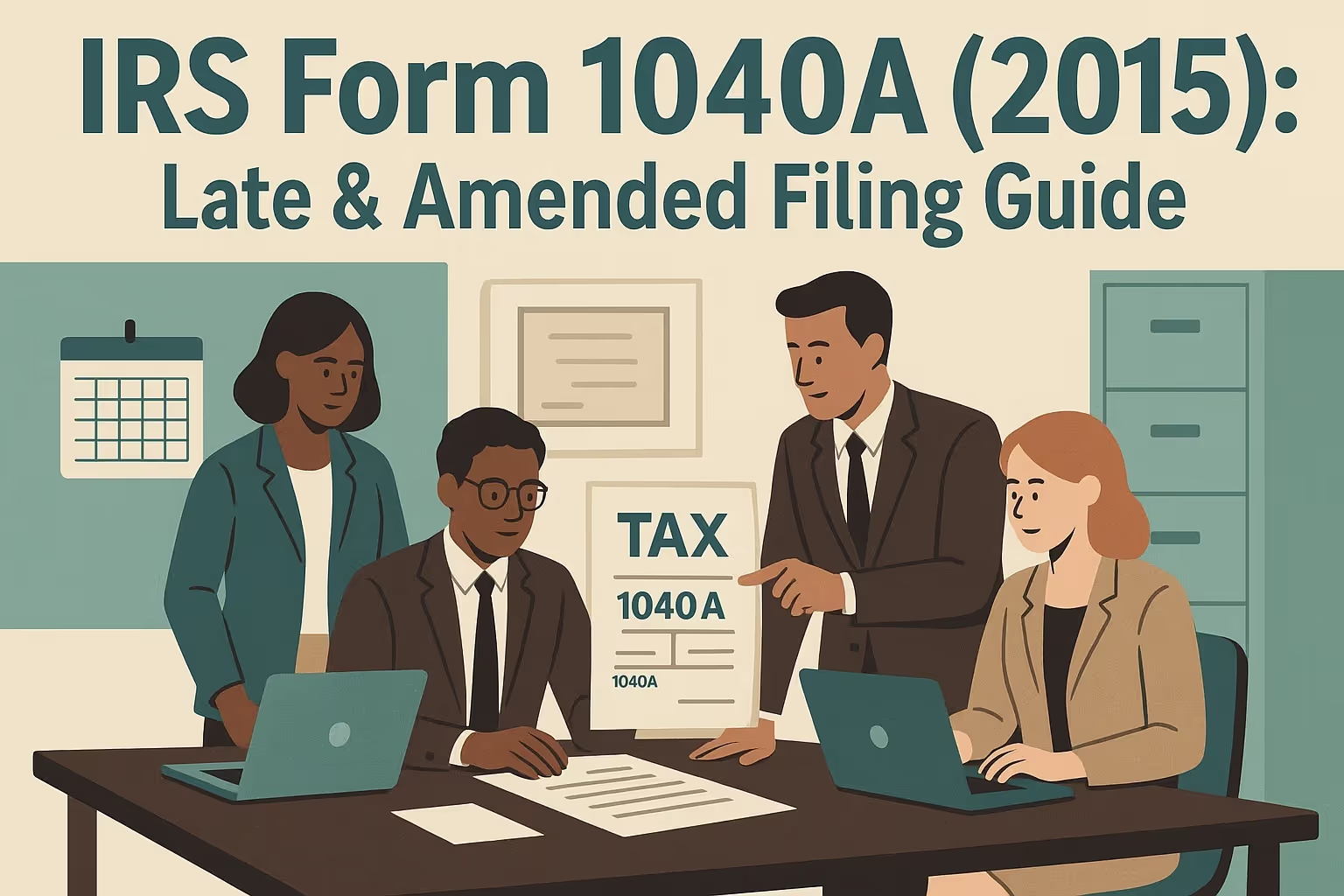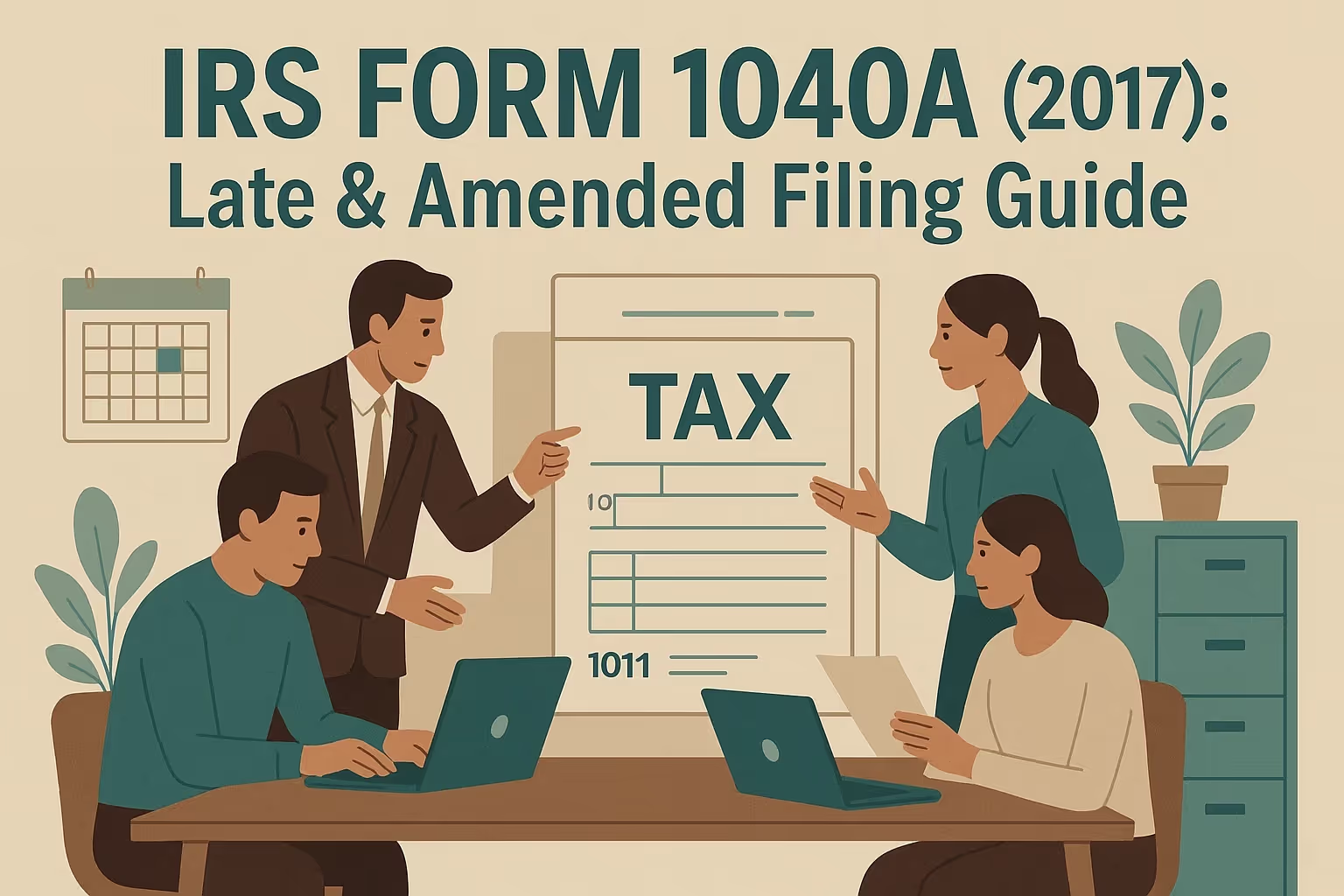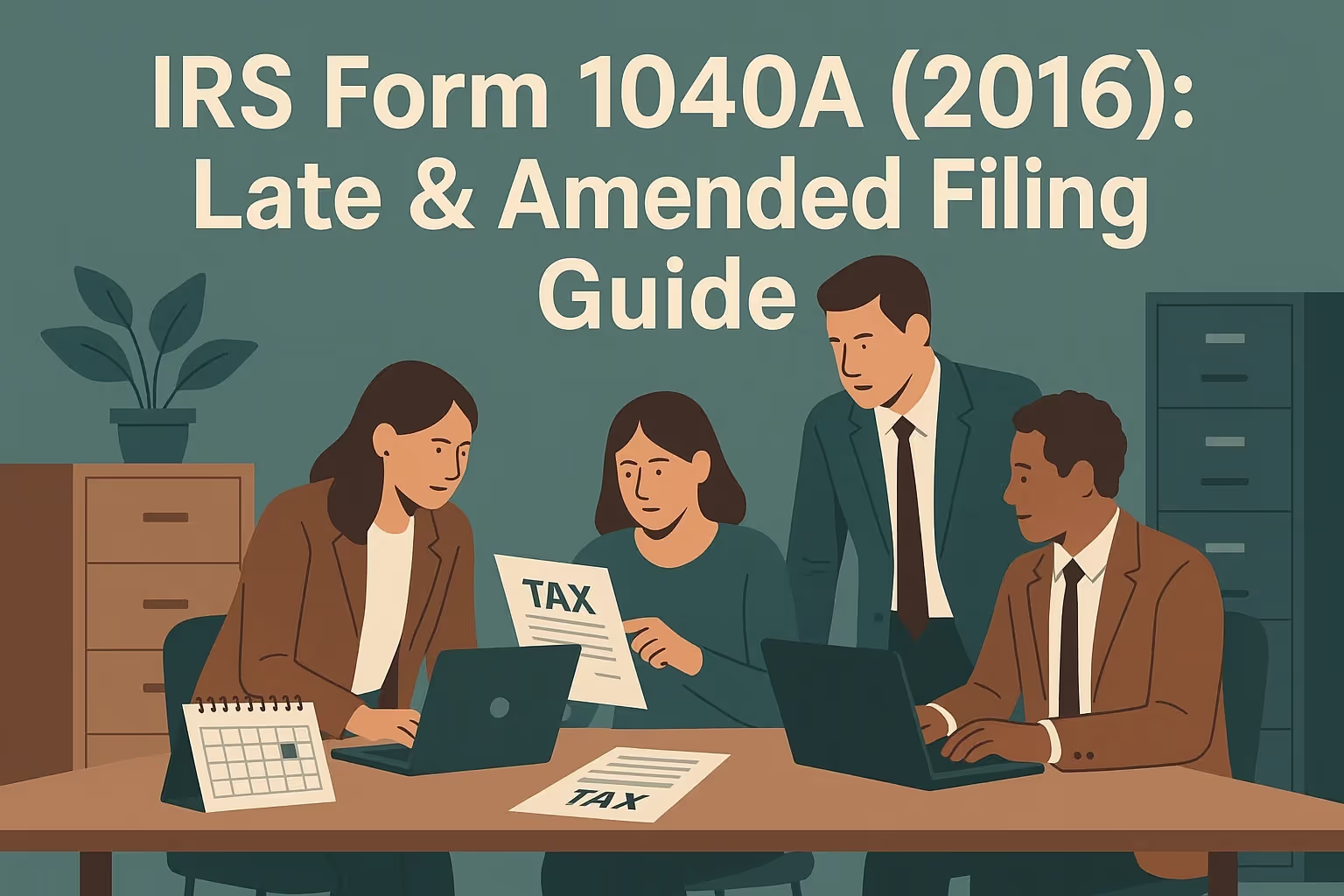
The 2018 income tax year introduced a redesigned Form 1040, replacing Form 1040A and Form 1040EZ. The Internal Revenue Service (IRS) adopted a more straightforward “building block” layout that allows taxpayers to file a basic return and attach only the schedules that apply to their situation. This shift represented one of the most significant changes in federal taxes in decades.
For many people, the change created new questions about how to file correctly. Taxpayers who once relied on the shorter 1040A needed clear guidance to prepare their returns under the new process. Understanding how filing status, deductions, credits, and forms work together helps ensure accuracy, reduce penalties, and increase the likelihood of receiving a max refund on time.
This guide explains the instructions for Form 1040A 2018 in detail and describes the filing process. It covers how to prepare and file taxes, pay any amount owed, and choose whether to use paper forms or tax preparation software. With practical information and expert help, taxpayers can confidently complete their returns now, knowing the process is accurate and straightforward.
Overview of the New Form 1040
Beginning with the 2018 tax year, the redesigned Form 1040 replaced the 1040A and 1040EZ; instead of separate forms for different levels of complexity, every taxpayer now completes the same core form. Additional schedules attach only when specific income, credits, or taxes apply.
The End of Form 1040A and 1040EZ
The IRS eliminated Forms 1040A and 1040EZ in 2018. Every taxpayer now files with the redesigned Form 1040. This rule applies to all filing statuses. No exceptions exist for any group of taxpayers.
The Building Block Approach
The IRS created a shorter form supported by six numbered schedules. These schedules handle additional income, credits, and special tax items. This structure makes tax filing more flexible.
Filing Requirements and Deadlines
Every person must determine if a tax return is required. The filing deadline for 2018 returns was April 2019, with extensions available. Filing on time helps avoid penalties and interest.
Schedules 1–6 Explained
- Schedule 1: Reports extra income such as business earnings, capital gains, or unemployment, along with adjustments like IRA deductions or student loan interest.
- Schedule 2: Covers items like alternative minimum tax or repayment of excess premium tax credits, which only apply to specific taxpayers yearly.
- Schedule 3: Lists nonrefundable credits such as education credits, foreign tax credit, or retirement savings contributions credit. These reduce total federal taxes owed.
- Schedule 4: Collects other federal taxes, including self-employment tax, household employment taxes, and additional tax on retirement accounts and similar plans.
- Schedule 5: Used for refundable credits and payments such as estimated taxes, earned income credit, or an extension payment previously submitted.
- Schedule 6: Provides space for a foreign address or authorizes a third party to contact the IRS directly regarding the person’s tax return.
What Changed in 2018 Federal Taxes
The Tax Cuts and Jobs Act created major updates that affected nearly every taxpayer. Before applying these instructions correctly, review the 2018 changes.
New Tax Brackets and Rates
The 2018 brackets included seven rates: 10%, 12%, 22%, 24%, 32%, 35%, and 37%. Most taxpayers saw lower rates compared to prior years.
Increased Standard Deduction
The standard deduction nearly doubled in 2018. Many taxpayers benefited from claiming the higher deduction instead of itemizing expenses such as mortgage interest.
Enhanced Child Tax Credit
The credit expanded to $2,000 per qualifying child. A portion became refundable, allowing families to qualify for additional money back, even with no tax liability.
Credit for Other Dependents
A new $500 nonrefundable credit became available for dependents who do not qualify for the child credit, including older children or certain relatives in the home.
Suspension of Personal Exemptions
Personal exemptions were suspended. Previously, taxpayers deducted amounts for themselves and dependents. The higher standard deduction replaced this reduction in taxable income.
Changes to Itemized Deductions
- SALT cap: State and local tax deductions are capped at $10,000, lowering available deductions for high-tax states.
- Miscellaneous deductions: Job expenses and other small miscellaneous deductions were removed entirely, simplifying return preparation but limiting options.
- Pease limitation repeal: Higher income taxpayers no longer saw limits on total itemized deductions, making the process simpler for large deduction claims.
Qualified Business Income Deduction
Self-employed individuals and small business owners became eligible for a new 20% deduction on qualified business income. This new deduction reduced taxable income and encouraged reinvestment.
Step-by-Step Instructions for Completing Form 1040
Following clear steps ensures taxpayers prepare their returns accurately and avoid delays. Each step builds on the last, making the process easy to follow.
Step 1: Determine if You Must File
Review IRS charts for filing thresholds. Filing requirements depend on age, filing status, and gross income. Even if not required, filing can return withheld money.
Step 2: Gather Required Documents
Collect forms received from your employer, banks, or investment companies. Keep W-2s, 1099s, and mortgage interest statements. Having complete information helps prepare an accurate return.
Step 3: Complete the Header Information
Provide filing status, name, and Social Security number. If married, include spouse information. Check the Presidential Election Campaign Fund checkbox if you agree to direct money there.
Step 4: List Dependents
Enter each dependent’s name, Social Security number, and relationship. Mark whether they qualify for the child tax credit or the credit for other dependents.
Step 5: Report Your Income
List all wages, salaries, and interest received during the year. Add retirement distributions and dividends. Attach schedules for business, rental, or capital gains income.
Step 6: Calculate Adjusted Gross Income
Combine all income sources and subtract eligible adjustments, such as IRA contributions or student loan interest. The result is adjusted gross income, which is used to determine deductions.
Step 7: Claim Standard or Itemized Deductions
Compare the standard deduction to total itemized deductions. Choose the higher amount. Itemizing may benefit taxpayers with high mortgage interest or large charitable donations.
Step 8: Determine Taxable Income
Subtract deductions from adjusted gross income. The result is taxable income if the amount is zero or negative.
Step 9: Figure Your Tax
Use IRS tax tables to determine the federal taxes owed. A worksheet is necessary for higher incomes. Tax preparation software can enhance accuracy and minimize errors.
Step 10: Apply Credits
Enter credits such as the child tax credit or education credits. Credits reduce your total tax directly, helping increase your refund or reduce the amounts you owe.
Step 11: Add Other Taxes
Include self-employment tax, additional Medicare tax, or retirement account penalties. These are reported using Schedule 4 and added to your total federal taxes owed.
Step 12: Report Payments
List withholding from your employer and estimated payments sent during the year. Add refundable credits, such as the earned income or premium tax credit.
Step 13: Determine Refund or Amount Owed
Compare payments and credits to the total tax. If you overpaid, a refund will be issued. If not, you will owe additional money.
Step 14: Sign and Date the Return
Sign and date the return. If filing jointly, both spouses must sign. Paid preparers must also complete and sign the acknowledgement section.
How to File Your Taxes
Taxpayers can choose to submit a tax return electronically or through paper filing. Filing electronically provides faster processing, greater accuracy, and quicker refunds. Paper filing remains available for those who prefer traditional methods. Both options require the form, schedules, and supporting information to be complete, accurate, and sent to the IRS on time.
Electronic Filing (E-File)
- Speed: Filing taxes online provides refunds within weeks compared to longer processing times with mailed paper returns.
- Accuracy: Tax preparation software checks for missing information and reduces common math errors.
- Confirmation: The IRS immediately acknowledges receipt of a return filed online, giving taxpayers confirmation and a receipt of submission.
- Security: Submitting through an authorized device ensures sensitive information is transmitted securely and directly to the IRS system.
IRS Free File Program
- Free File Software: Taxpayers who qualify based on income may prepare and send their tax return using brand-name software at no cost.
- Fillable Forms: Electronic versions of paper forms allow anyone to complete, prepare, and file taxes online with built-in calculations but no expert guidance.
Paper Filing
- Traditional Process: Print completed forms, attach required schedules, and mail to the IRS. This method takes longer and requires more handling.
- Proof of Filing: Use certified mail or approved delivery services to confirm the IRS received your return and to prove timely filing.
- Signatures: Signing in ink is mandatory. Unsigned returns are not accepted and may lead to penalties or delayed refunds.
Payment Instructions
If a taxpayer owes federal taxes, several payment methods are available. The IRS provides electronic and traditional options, each offering convenience, accuracy, and secure processing. Choosing the correct payment option helps taxpayers manage their money effectively while avoiding additional penalties and interest.
Direct Pay from Bank Account
- No Fees: Direct Pay allows one to send money directly from a checking or savings account without processing charges.
- Flexibility: Payments can be scheduled up to one year in advance, making the process easy to manage today or later.
- Control: Taxpayers may cancel or modify scheduled payments through IRS systems at least two business days before the payment date.
Electronic Federal Tax Payment System (EFTPS)
- Enrollment: Register online to prepare, schedule, and send payments for federal taxes through a secure electronic system backed by the Treasury.
- Access: Payments can be made by phone or computer. The service is available 24/7 and offers flexibility and reliability for taxpayers.
Credit or Debit Card Payments
- Third-Party Fees: Paying with a card incurs a small percentage fee charged by an authorized processor, not the IRS.
- Convenience: This option allows taxpayers to use personal financial accounts to settle their tax return balance.
Check or Money Order with Form 1040-V
- Proper Labeling: Checks must be payable to the United States Treasury and include the Social Security number, year, and form type f
- Voucher: Include Form 1040-V payment voucher with the check or money order so the IRS can apply the payment directly to your account.
Payment Plans
- Short-Term Plans: Allow taxpayers who owe smaller amounts to pay within 120 days, with no setup fee and limited interest.
- Long-Term Agreements: Provide monthly installment options for larger balances. Interest and penalties continue until the balance is paid in full.
Required Schedules and Attachments
Not all taxpayers need additional schedules, but many must complete them to ensure accuracy. Each schedule provides specific details for income, deductions, or credits. Attaching the correct schedules helps the IRS process a tax return without questions or delays.
Schedules 1–2
- Schedule 1: This is used for additional income such as unemployment compensation, gambling winnings, or deductible adjustments, including student loan interest.
- Schedule 2: Reports alternative minimum tax and repayment of advance premium tax credits, applicable only in certain complex tax filing situations.
Schedules 3–4
- Schedule 3: Reports nonrefundable credits such as foreign tax credit, education credits, or general business credits claimed by the taxpayer.
- Schedule 4: Adds other federal taxes, such as self-employment tax, household employment tax, or penalties on early retirement account withdrawals.
Schedules 5–6
- Schedule 5: Covers refundable credits and additional payments, including earned income credit or prior year tax payments applied forward.
- Schedule 6: Records foreign addresses and authorizes third parties to contact the IRS about your return on your behalf.
Other Common Forms
- Schedule A: For itemized deductions like mortgage interest, medical expenses, and charitable contributions, instead of taking the standard deduction.
- Schedule B: Reports interest and dividend income exceeding $1,500, or details foreign accounts held during the tax year.
- Schedule C: For business income or loss when operating as a sole proprietor, requiring additional details about expenses and gross receipts.
- Schedule D: Summarizes capital gains or losses from selling investments such as stocks, bonds, or real estate during the year.
- Schedule SE: Calculates self-employment tax when net earnings exceed $400, ensuring Social Security and Medicare contributions are recorded.
Common Mistakes to Avoid
Accuracy is critical when completing a tax return. Many taxpayers experience delays or penalties due to common mistakes. Avoiding these errors saves time, money, and stress when working with the IRS.
Math and Calculation Errors
- Issue: Simple addition or subtraction mistakes delay processing and may reduce your refund or increase the amount you owe unexpectedly.
- Solution: Use tax preparation software to ensure accuracy or review all manual calculations before signing the return.
Social Security Number Problems
- Issue: Missing or incorrect Social Security numbers for dependents prevent taxpayers from qualifying for credits and can reduce their refund.
- Solution: Verify all numbers against official Social Security cards to ensure accuracy before submitting your completed forms.
Filing Status Errors
- Issue: Choosing the wrong filing status changes deductions, credits, and overall taxes owed, resulting in either underpayment or lost refund opportunities.
- Solution: Review IRS guidance or use software to find the correct filing status before you prepare and complete your tax return.
Missing Signatures
- Issue: Unsigned paper returns are considered incomplete. The IRS will not process the return, delaying refunds and possibly leading to penalties.
- Solution: Always check the signature section before mailing. Electronic returns require taxpayers to acknowledge submission using a PIN or device code.
Bank Account Information Errors
- Issue: Incorrect direct deposit details cause refunds to be delayed or misdirected, forcing the taxpayer to contact the IRS for corrections.
- Solution: Double-check routing and account numbers when entering information to receive your refund quickly and without complications
Zero Activity / Dormant Year Guidance
Even taxpayers with little or no annual income may need to file a tax return. Certain conditions require filing, while others make filing optional but beneficial. Filing in these cases can help secure refunds, avoid penalties, and ensure accurate reporting with the IRS.
When You Must File with Minimal Income
- Special Taxes: You must file if you owe self-employment tax, alternative minimum tax, or household employment taxes during the year.
- Marketplace Credits: If you received advance premium tax credits for health insurance, you must file to reconcile payments with your actual income.
When Filing Provides a Refund
- Refundable Credits: Even if you owe nothing, filing may return money through credits such as the earned income credit or the additional child tax credit.
- Withholding Refunds: If your employer withheld federal taxes from paychecks, filing a return allows you to receive a refund for overpaid amounts.
Low-Income Taxpayer Situations
- Students: May need to file if they had taxable scholarships, part-time income, or qualified for education credits during the year.
- Retirees: Required if retirement distributions or taxable Social Security benefits exceed thresholds. Filing may also return withheld federal taxes.
- Unemployed Individuals: Must consider filing if unemployment compensation is received, taxes were withheld, or credits are available.
First-Time Filer Tips
Completing a first tax return can feel overwhelming. However, with preparation, the process becomes more manageable. Gathering correct information, using tax preparation software, and following IRS guidance help new taxpayers file confidently and accurately, ensuring they qualify for refunds and avoid unnecessary penalties.
Preparation Checklist
- Documents: Collect W-2s, 1099s, bank statements, and any records of deductible expenses before starting to file.
- Method: Decide whether to file taxes online with tax preparation software or complete paper forms for mailing to the IRS.
- Organization: Create a filing system, either digital or paper, to keep track of forms, schedules, and IRS correspondence for accuracy.
Key Tax Terms Explained
- Gross Income: All income received before deductions determines whether filing a tax return is required for the year.
- Adjusted Gross Income (AGI): Gross income minus deductions such as IRA contributions or student loan interest, used to calculate credit eligibility.
- Credits vs Deductions: Credits reduce tax directly, while deductions lower taxable income. Both are essential to maximizing a refund and reducing liability.
Standard vs. Itemized Deductions
- Standard Deduction: Most taxpayers choose the standard deduction, which was higher in 2018 and simplified filing for many people.
- Itemized Deductions: Beneficial if total deductions, including mortgage interest, medical expenses, and charitable contributions, exceed the standard deduction amount.
Frequently Asked Questions
Do former Form 1040A filers need to follow the new instructions?
Yes, beginning in the 2018 tax year, all taxpayers used the new Form 1040. The IRS eliminated Forms 1040A and 1040EZ to simplify filing. The new form relies on additional schedules only if needed, making the process easy for simple cases but providing flexibility for complex returns. The Form 1040A 2018 instructions apply directly to these changes.
How do I know which schedules to attach to my tax return?
The IRS instructions provide a clear guide for schedules. Most taxpayers file only the base Form 1040. However, you must complete the related schedules if you report additional income, credits, or special taxes. Tax preparation software can help identify required attachments automatically, while paper filers must carefully read IRS guidance to prepare and submit schedules correctly.
Should I take the standard deduction or itemize deductions like mortgage interest?
The best choice depends on which deduction gives you more savings. For 2018, the standard deduction nearly doubled, meaning most taxpayers benefited from it. However, itemizing may still help if you paid significant mortgage interest, medical expenses, or charitable contributions. Compare both totals before you file to ensure you receive the maximum refund or reduce taxes owed.
What happened to personal exemptions for the 2018 income tax year?
Under the Tax Cuts and Jobs Act, personal exemptions were suspended for the tax year 2018. Previously, taxpayers reduced taxable income by claiming exemptions for themselves and dependents. Although exemptions were removed, the standard deduction increased significantly, offsetting the loss for most taxpayers. The Form 1040A 2018 instructions reflect these adjustments and explain how to apply them when filing.
How does the child tax credit differ from the new credit for other dependents?
The child tax credit increased to $2,000 per qualifying child, with up to $1,400 refundable. In contrast, the credit for other dependents provides a $500 nonrefundable credit for dependents who do not qualify as children, such as older children or certain relatives. Both credits help reduce federal taxes and increase refund potential for eligible taxpayers filing returns.
How long will it take to receive my refund after I file?
Refunds typically arrive within three weeks when you file taxes online and choose direct deposit. Paper returns can take six to eight weeks. Using accurate information, avoiding mistakes, and confirming direct deposit details help reduce delays. The IRS offers an online tool called “Where’s My Refund?” so taxpayers can track refund status after submitting their tax return.


























